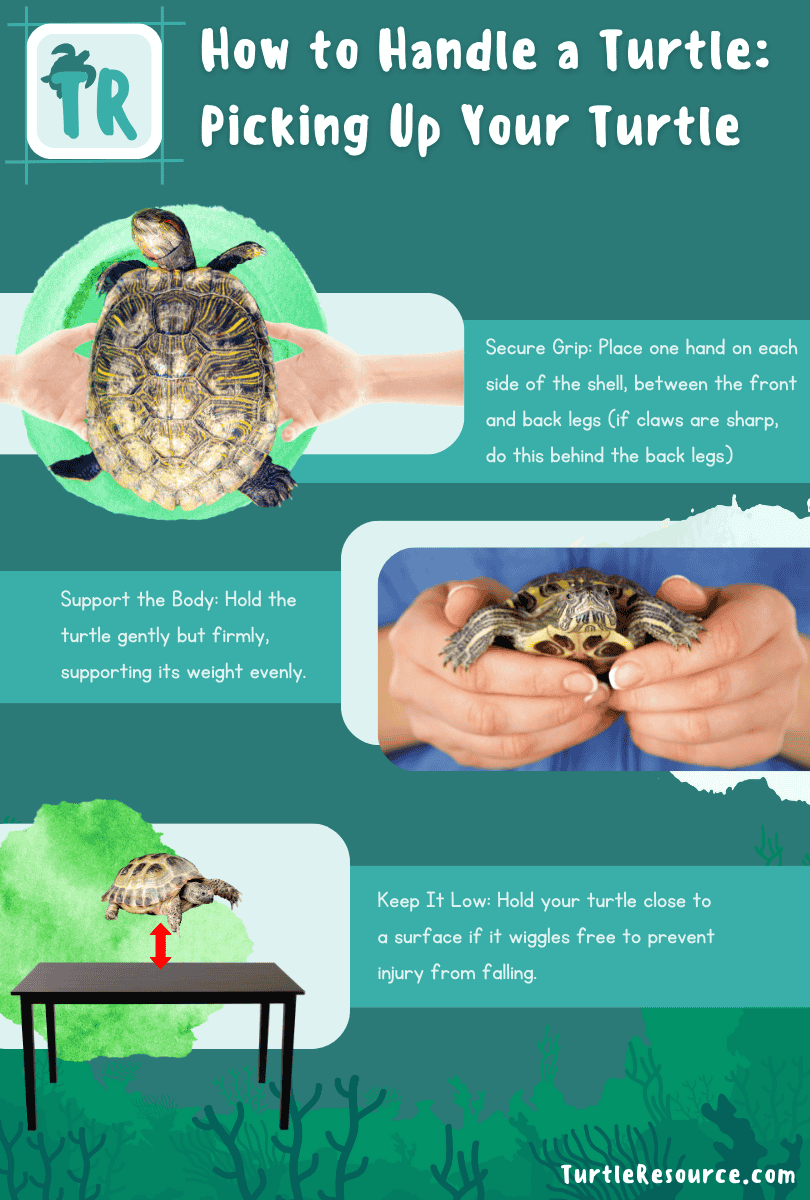Turtle Handling and Interaction
Learn how to safely handle and interact with your pet turtle. Our guide offers tips to build trust and enrich your bond.

Interacting with your pet turtle can be a rewarding experience that strengthens the bond between you and your shelled friend. Understanding how to handle your turtle correctly is paramount for its safety and well-being, as well as your own.
This guide will provide tips and best practices for handling and interacting with your turtle. We'll cover how to pick up your turtle safely, how to recognize signs of stress, and ways to enrich your turtle's life through interaction.
Whether you're a new turtle owner or looking to deepen your connection, this article will help you engage with your turtle confidently and responsibly.
Understanding Your Turtle's Behavior
Understanding your turtle’s natural tendencies is key to creating a safe, enriching environment. Turtles are often shy or territorial, preferring to pull into their shells or hide when threatened. However, with patience, they can grow curious about their owners.
It’s crucial to watch for signs of stress, such as retreating, hissing, or biting, to adjust your approach and give them room to feel at ease. By learning turtle communication, reading signals, and respecting their boundaries, you’ll help your turtle feel secure, build trust, and enjoy a healthier, happier life under your care.

Natural Tendencies
- Shy Creatures: Turtles are naturally cautious and may retreat into their shells when threatened.
- Territorial: Some turtles may be protective of their space and not enjoy being handled frequently.
- Curious: With time and patience, many turtles become curious about their owners and surroundings.
Signs of Stress
- Retreating: Pulling into their shell or hiding frequently.
- Hissing: A hissing sound indicates discomfort or fear.
- Biting: Attempting to bite when approached may indicate stress or aggression.
Recognizing these behaviors will help you interact with your turtle in a way that minimizes stress and builds trust.
How to Handle a Turtle: Safe Turtle Handling Techniques
Handling your turtle correctly ensures both safety and comfort—yours and your turtle’s. Because turtles can become stressed when improperly lifted, understanding gentle, secure techniques is essential.
From washing your hands and moving quietly, to supporting the shell and avoiding limb-grabbing, proper handling fosters trust and helps keep your turtle healthy.
Whether you have an aquatic turtle with sharp claws or a land-dwelling tortoise needing solid bottom support, learning the right methods reduces the risk of injury and stress.
By following these simple guidelines, you’ll develop a stronger, more confident bond with your shelled companion.
Preparing to Handle Your Turtle
- Wash Your Hands: Always wash your hands before and after handling your turtle to prevent the spread of bacteria like Salmonella.
- Calm Environment: Approach your turtle quietly without sudden movements or loud noises.

Picking Up Your Turtle
- Approach from the Front or Side: Let your turtle see you coming to avoid startling it.
- Secure Grip: Place one hand on each side of the shell, between the front and back legs. If your picking up a turtle with sharp claws, grab them behind the legs.
- Support the Body: Hold the turtle gently but firmly, supporting its weight evenly.
- Keep It Low: Hold your turtle close to a surface if it wiggles free to prevent injury from falling.

Handling Aquatic Turtles
- Be Cautious of Scratches: Aquatic turtles have sharp claws; consider wearing gloves.
- Wet Hands: Slightly damp hands can provide a better grip and prevent turtle skin damage.
Handling Land Turtles (Tortoises)
- Support the Plastron: Place your hand under the bottom shell for additional support.
- Avoid Grabbing Limbs: Never pull or hold a turtle by its legs, tail, or head.
Here's a video for turtle with sharp claws:
Credits: TurtleHolic
Interaction Tips to Improve Turtle Handling
Improving turtle handling starts with patience, understanding, and trust. Spend regular time near your turtle so it recognizes you, speak gently, and try hand feeding to build positive associations.
Encourage exploration in a safe area beyond the tank and enrich its habitat with new elements or visual stimulation. Keep handling sessions short to prevent stress, and respect your turtle’s boundaries if it seems uneasy.
With consistent, gentle interaction, you’ll help your turtle feel secure and engaged in its environment, creating a stronger bond and a more fulfilling relationship for both of you.
Building Trust
- Regular Interaction: Spend time near your turtle's enclosure so it becomes familiar with your presence.
- Gentle Voice: Speak softly to your turtle to help it recognize your voice.
- Hand Feeding: Offer food from your hand to create positive associations.
Enrichment Activities
- Exploration Time: Allow your turtle supervised time in a safe, enclosed area to explore outside its tank.
- Environmental Enrichment: Add new elements to the enclosure, like plants or toys, to stimulate curiosity.
- Visual Stimulation: Place the tank where your turtle can observe household activities without being overwhelmed.
Social Interaction
- Handling Duration: Keep handling sessions short, about 10-15 minutes, to prevent stress.
- Respect Boundaries: If your turtle shows discomfort, return it to its enclosure.
Safety Considerations
Health Precautions
- Avoid Face Contact: Do not bring your turtle close to your face to prevent bites or bacterial exposure.
- Supervise Children: Teach kids how to handle turtles gently and always supervise interactions.
Protecting Your Turtle
- Secure Environment: Ensure the area where you handle your turtle is safe and escape-proof.
- Temperature Awareness: Avoid handling your turtle in extreme temperatures; maintain a comfortable environment.
Salmonella Awareness
- Understand the Risk: Turtles can carry Salmonella bacteria, which can cause human illness.
- Proper Hygiene: Wash your hands thoroughly with soap and water after handling your turtle or anything in its environment.

Recognizing and Preventing Stress
Signs Your Turtle Is Comfortable
- Active Exploration: Moves around freely during handling.
- Eating Well: Accepts food from your hand or in your presence.
- Expected Behavior: Displays typical behaviors like basking and swimming.
Reducing Stress
- Slow Movements: Move calmly and avoid sudden gestures.
- Quiet Environment: Minimize loud noises and disturbances.
- Routine: Establish a consistent schedule for feeding and interaction.
When Not to Handle Your Turtle
During Illness
- Sick Turtles: Limit handling if your turtle is unwell to reduce stress and prevent the spreading of illness.
- Signs of Illness: Lethargy, lack of appetite, or abnormal behavior.
After Changes
- New Environment: Give your turtle time to adjust to a new enclosure before handling.
- Recent Feeding: To handle it, wait an hour after your turtle has eaten.
Interaction Activities
Feeding Time
- Variety of Foods: Offer different types of food to keep your turtle interested.
- Interactive Feeding: Use feeding tongs or place food in different areas to encourage natural foraging behaviors.
Training Basics
- Simple Commands: Some turtles can learn to come to a specific spot when called or when they see you.
- Positive Reinforcement: Reward desired behaviors with treats.
Behavioral Plasticity and Trainability in Turtles
While turtles are not traditionally viewed as easily trainable pets, research on their cognitive capacities indicates a surprising degree of behavioral plasticity. Unlike some mammals and birds, which exhibit more rapid learning responses, turtles generally possess slower metabolisms and lower activity levels, potentially reducing the motivation to engage in consistent training exercises.
However, studies have documented that turtles can learn to recognize feeding cues, navigate mazes, and even respond to certain stimuli through repetition and positive reinforcement. These findings suggest that training outcomes depend on a careful approach that acknowledges the reptilian pace of learning, where frequent, gentle prompts and rewards can gradually shape desired behaviors.
In practice, training might involve teaching a turtle to come to a specific location for feeding or to move onto a platform for medical examinations. Such tasks rely on associating consistent signals, like a light tapping or gentle sound, with a reward—often a preferred food item. Although not all species exhibit equal trainability, even tortoises, known for their deliberate movements, have demonstrated memory retention and problem-solving when offered consistent incentives.
Overall, success depends on patience, an understanding of each species’ behavioral ecology, and an emphasis on welfare-oriented practices that respect the turtle’s natural tendencies and limitations.
Sources
– Gibbons, J.W. Turtles of the Southeast.
– Highfield, A.C. Practical Encyclopedia of Keeping and Breeding Tortoises and Freshwater Turtles.
– Wilkinson, A. & Huber, L. “Reptile Cognition.” Current Biology, vol. 22, no. 9, 2012.
Conclusion
Handling and interacting with your turtle can significantly enhance your pet ownership experience. Understanding your turtle's behavior and needs can build a trusting relationship that benefits you and your pet.
Always handle your turtle carefully, respect its boundaries, and prioritize its safety and comfort. With patience and consistency, you'll find that your turtle becomes more comfortable and responsive during interactions, making your time together even more enjoyable.
